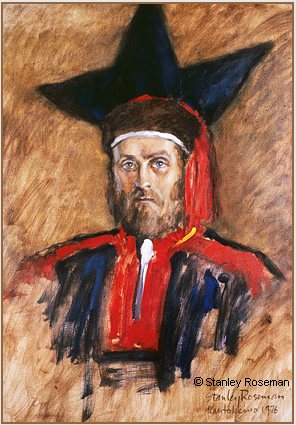

© Stanley Roseman and Ronald Davis - All Rights Reserved
Visual imagery and website content may not be reproduced in any form whatsoever.
Visual imagery and website content may not be reproduced in any form whatsoever.
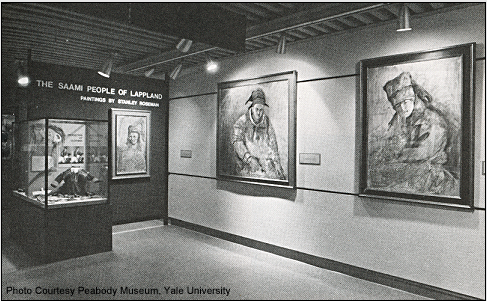
Yale University's Peabody Museum presented The Saami People of Lappland exhibition in September-October 1977. Discovery, the biannual journal of the Peabody Museum, published an enthusiastic reportage on the exhibition and praised ''this handsome assemblage devoted to a remote but unique society."[1]
The Saami People of Lappland exhibition featured Stanley Roseman's paintings, along with a selection of artifacts and documentary information from the collections of anthropologist Myrdene Anderson and the Peabody Museum.
In the photograph, (fig. 1), are Roseman's oil on canvas portraits (left to right): Biret; Bier An'te, a portrait of the reindeer herder wearing his white reindeer fur coat; and An'te Niilas, the Saami couple's teenage grandson.
1. Peabody Museum, Yale University
The panel reads: "The Saami People of Lappland
Paintings by Stanley Roseman."
The panel reads: "The Saami People of Lappland
Paintings by Stanley Roseman."
The international news agency Agence France Presse covered the Yale University exhibition and writes:
''The creation of the portraits of these nomads, an endeavor especially difficult in light of their seasonal migrations, fostered a close relationship between the Saami and the artist, who became their temporary companion. The exhibition constitutes an ethnological and artistic work that has never been brought to such a successful realization.''
- Agence France Presse
''Art and Anthropology at the Peabody.''
The Morning Record & Journal, Meriden, Connecticut, entitled its laudatory review ''Art and Anthropology at the Peabody.'' The Connecticut daily praises ''The excellent exhibit'' and commends the successful collaboration between artist Stanley Roseman and anthropologist Myrdene Anderson, who had returned to Yale University, where she earned her doctorate degree the following year.
2. Stanley Roseman, Myrdene Anderson, and Ronald Davis
standing before the artist's portrait of the reindeer herder Mát'te
at the opening of the exhibition The Saami People of Lappland,
Peabody Museum, Yale University, 1977.
standing before the artist's portrait of the reindeer herder Mát'te
at the opening of the exhibition The Saami People of Lappland,
Peabody Museum, Yale University, 1977.
The Peabody Museum journal Discovery writes that the exhibition was produced by Ronald Davis in association with Keith Stewart Thomson, Director of the Peabody Museum; Myrdene Anderson; Louise Lauretano DeMars, Senior Exhibit Designer; and the Museum's curatorial staff.[2]
''The exhibited portraits are larger than life," writes The Morning Record & Journal. "Detail in the portraits is concentrated in the faces and sometimes in the hands. These are opaquely painted in full modeling, each strong, expressive, and individual.''
7. Mát'te (detail), 1976
Lappland
Oil on canvas, 117 x 86 cm
Private collection
Lappland
Oil on canvas, 117 x 86 cm
Private collection
Mát'te is a commanding presence in the superb portrait, (fig. 7). The reindeer herder with blue eyes, prominent cheekbones, and ruddy complexion wears his Saami hat and heavy, woolen tunic and holds a hand to his lips as he smokes a cigarette and looks out from the canvas. Here, as in other Roseman portraits of the Saami, "the clothing is painted boldly, but in masses suggesting its form and bulk," observes The Morning Record & Journal.
The Times, London, praises Roseman's work in Lappland as "an epic project" and states:
"The Saami paintings are magnificent."
- The Times, London
Lappland
The previous website page "The Saami People of Lappland" relates Roseman and Davis' journey to Lappland in 1976 and their chance meeting with Anderson, who at the time was completing five years of field-work among the Saami people. Anderson was enthusiastic about Roseman's interest as an artist in the nomadic Saami and thoughtfully offered him and his colleague to be their guide in helping them become acquainted with the region and its people, and she very kindly took on the task of translator as Roseman and Davis spoke neither Norwegian nor the Saami language. "I learned very much from Myrdene about the Saami culture," recounts the artist, "and I am deeply grateful for her encouragement and enthusiasm for my work."
After doing research on the Saami people and their culture, Roseman and Davis traveled from New York to Norwegian Lappland, with their final destination being the rural township of Kautokeino in Finnmark County. A few days after the artist and his colleague had arrived in Kautokeino, they met Myrdene Anderson, today a distinguished anthropologist, botanist, and linguist.
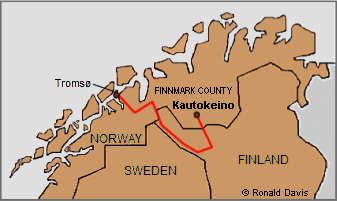
Lappland, also spelled Lapland, the ancestral home of the Saami, or Lapps, comprises northern Norway, Sweden, Finland, and the Kola Peninsula of Russia.
The two friends left Tromsø and drove some 400 kilometers on the one main road that led east through Norway and into Finland, from where they travelled southeast before turning north to recross the Norwegian border and continue on to the rural township of Kautokeino, situated just above the 69th parallel.
Roseman's interest as an artist in Lappland was in the nomadic Saami, an independent, reindeer herding people who inhabit one of the world's harshest environments, as recounted on the previous website page.
Highly respected by the Saami, Anderson introduced Roseman to friends of hers who she thought would be responsive to sitting for an artist. The nomadic Saami do not have in their culture the tradition of portraiture, specifically life-size portrait paintings.
Despite the reserve that the Saami held towards those outside their community, a rapport of trust and understanding was established between the Saami and the artist, as is related on the previous page with a selection of Roseman's portraits and accompanying texts.
Lappland
Roseman and Davis stayed for a few days in the coastal city of Tromsø to acclimate themselves to the Arctic region and do additional research before making their way to the interior of Lappland.
Portraiture
"Roseman's Saami paintings . . . . They give an overwhelming sense of individuality and humanity."
Portraiture holds an important place in Roseman's oeuvre and has brought him great esteem. Aftonbladet, Stockholm, Sweden's leading daily, published in 1980 in its Sunday magazine a cover story on the artist. Aftonbladet commends Roseman for creating portraits "artistically on a high level as well as accurately expressive of the human dimension.''
Nordisk Tidende, America's leading Norwegian newspaper announced the forthcoming autumn 1977 exhibition The Saami People of Lappland at Yale University's Peabody Museum with an enthusiastic reportage that begins: "The well-known American portraitist Stanley Roseman and his friend and colleague Ronald Davis have returned from an adventurous trip to Finnmark in Norway with stunning portraits of distinctive Kautokeino Saami."
"stunning portraits . . . . This is first-class art."
- Nordisk Tidende, New York
- Aftonbladet, Stockholm
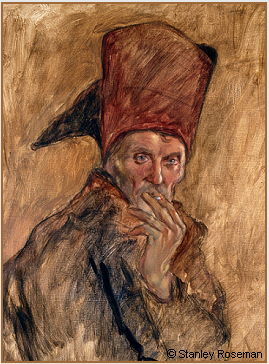
Return to the previous page The Saami People of Lappland
The SAAMI PEOPLE of LAPPLAND Exhibition
Peabody Museum, Yale University
Peabody Museum, Yale University
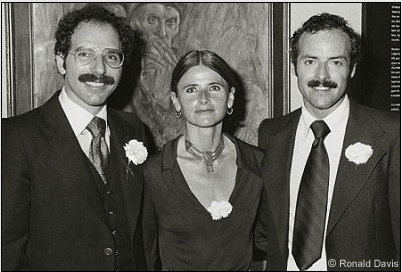
The American-Norwegian daily further praises Roseman's
5. Bier An'te (detail), 1976
Lappland
Oil on canvas, 120 x 120 cm
Collection of the artist
Lappland
Oil on canvas, 120 x 120 cm
Collection of the artist
In the beautiful portrait Bier Ante Ris'ten, a soft northern light illuminates the Saami woman's lovely, oval face. Expressive brushstrokes, a hallmark of Roseman's paintings, describe the tunic, bonnet, and shawl; accents of red and yellow, as in the other Saami portraits, complement the predominant earth colors in the paintings. The pyramidal composition gives strength to the presentation of the figure. Ris'ten sits with a hand to her cheek and offers a sympathetic regard as she looks out from the canvas. Roseman recounts:
''Some days later, Ris'ten graciously invited Ronald, Myrdene, and me for dinner at her home with her husband and An'te Niilas. That invitation was especially meaningful as the nomadic Saami hold a reserve towards those outside their community and was a thoughtful gesture that affirmed her appreciation of my work. Ris'ten prepared a delicious dinner of reindeer stew, a specialty of the Saami cuisine, and the time we shared together was memorable."
6. Bier Ante Ris'ten, 1976
Lappland
Oil on canvas, 98 x 80 cm
Collection of Ronald Davis
Lappland
Oil on canvas, 98 x 80 cm
Collection of Ronald Davis
"My contact with the Saami was an enriching experience for my art and for my life,
more than I had hoped for or could have foreseen
when Ronald and I embarked on our journey to Lappland."
more than I had hoped for or could have foreseen
when Ronald and I embarked on our journey to Lappland."
- Stanley Roseman
"Bier An'te Ris'ten, a very pleasant woman in her forties, was a reindeer herder, like her father, Bier An'te. For generations Saami women as well as men engaged in reindeer herding. The sharing of such a primary subsistence activity has a precedent in the early history of the Saami, as recorded in the first century by Tacitus, who notes that women supported themselves by hunting along with the men.[3] Regarding 'reindeer pastoralism' in Saami society today explains Myrdene Anderson, 'both sexes and virtually all ages traditionally have shared in herding chores. . . .'[4]
In further appreciation Roseman writes: "I am deeply grateful to Ris'ten for her encouragement of my work, for bringing me into her home and that of her parents', and for kindly sharing with me a part of her family life and the Saami culture."
Having painted portraits of Bier An'te, Biret, and An'te Niilas, Roseman asked Ris'ten if she would sit for him so that he could include a portrait of her in his work in Lappland. Ris'ten kindly offered her time which resulted in the oil on canvas portrait presented below, (fig. 6).
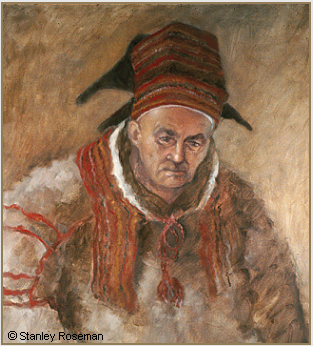
Roseman recounts that Bier An'te was enthusiastic about sitting for him and in so doing, thoughtfully offered his encouragement to the artist in his work in Lappland.
Bier An'te is an impressive portrait with a strong presence of the individual, (fig. 5). With painterly textures and chiaroscuro modeling of light and shade, Roseman renders Bier An'te's white reindeer fur coat with red tassel and multi-colored decorative braiding. The voluminous, fur coat attests to the long, cold winters in Lappland. Bier An'te wears the traditional Saami hat worn by men from the region of Kautokeino. From the crown of the high hat emerge three dark, tubular forms of woolen material that the artist indicated by abstract, triangular shapes silhouetted against summary earth tones of the background.
The reindeer herder Bier An'te is the subject of two oil on canvas portraits that Roseman painted in the Saami man's cabin, situated on an isolated tract across the Cábardasjohka River in Kautokeino township. The episode of crossing the river in a rowboat carrying Bier An'te's daughter Ris'ten; her brother, who rowed the boat; An'te Niilas; Myrdene Anderson, and two herding dogs; as well as the artist and his colleague, who helped to transport the art materials, is related with photographs on the previous page. Also related with text and photograph is the equally precarious return on foot some days later and carrying the paintings over a frozen stretch of the river.
A portrait of Bier An'te is seen in the photograph of the exhibition at the top of the page and below. Another portrait of Bier An'te is presented at the top of the previous page and in fig. 3, with accompanying text.
The Saami man of advancing years looks pensively out from the canvas. The circular leitmotif of fur collar and white fur trim and bands of braiding on the hat bring the focus of the composition to the Saami man's face, which the artist has finely rendered with cool highlights and warm shading. Roseman writes: "Bier An'te's physiognomy and weathered complexion revealed a long, hard life as a reindeer herder in the harsh, Arctic terrain.''
Bier An'te's daughter Ris'ten is the subject of the portrait below, (fig. 5). A friend and neighbor of Anderson in the rural hamlet of Soaht'tofiel'bmá, Ris'ten invited Roseman and Davis to meet her parents and thoughtfully asked the artist if he would like to bring his painting materials with him. Roseman writes of Ris'ten:
Roseman's portraits of the Saami include several members of a family as with Bier An'te, Biret, their daughter Ris'ten; and their grandson An'te Niilas; the reindeer herder Issát and his wife Sunne Ris'ten; and the reindeer herder Mat'te and his teenage daughter Inger El'le. Roseman's masterly technique in the art of portraiture is further exemplified by the portrait Mat'te, also presented here from The Saami People of Lappland exhibition.
Roseman relates painting the portrait of Mát'te: ''It is customary that when the nomadic Saami begin a task they continue until the work is completed, and Mát'te projected this Saami way of doing things by kindly sitting for me as long as I needed for my work. . . . And it seemed as though Mát'te smoked that one hand-rolled cigarette throughout the time I painted his portrait, when in fact Mát'te rolled and smoked several cigarettes in succession and thoughtfully held his pose while he sat for me that afternoon."
1. Discovery, Vol. 12, No. 3 (New Haven: Peabody Museum, Yale University, 1977) p. 56.
2. Ibid, p. 57
3. Tacitus, Germania, 98 A.D.
4. Myrdene Anderson, "Woman as Generalist, as Specialist, and as Diversifier in Saami Subsistence Activities,"
(Humboldt Journal of Social Relations, Vol. 10, No. 2, spring-summer 1983), p. 181.
2. Ibid, p. 57
3. Tacitus, Germania, 98 A.D.
4. Myrdene Anderson, "Woman as Generalist, as Specialist, and as Diversifier in Saami Subsistence Activities,"
(Humboldt Journal of Social Relations, Vol. 10, No. 2, spring-summer 1983), p. 181.
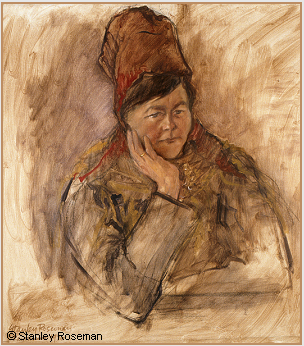
Biography: Page 5
Continued
Continued
Please note that the website has been republished for Internet Explorer 11.
4. Regnor, 1976
Lappland
Oil on canvas, 98 x 80 cm
Private collection, New York
Lappland
Oil on canvas, 98 x 80 cm
Private collection, New York
Presented here is the impressive oil on canvas portrait Regnor, 1976, (fig. 4). Painting in the region of Kautokeino, Roseman had the opportunity to include in his work a Saami man from the region of Karasjok, adjacent to and east of Kautokeino. Regnor Solbakk was the second President (1971-1973) of the Norske Samers Riksforbund(Norwegian Saami Association) founded in 1968 and headquartered in Kautokeino. Regnor, who spoke English, warmly welcomed Roseman and Davis recently arrived in Kautokeino and greatly encouraged the artist in his prospective work in Lappland. "I am sincerely appreciative to Regnor for his encouragement," recounts Roseman, "and for granting my request to him to sit for a portrait."
Regnor wears the tunic and hat that are the traditional clothing of Saami men from Karasjok. The Morning Record and Journal in its review of The Saami People of Lappland exhibition describes the portrait as "striking and colorfully painted, with head and shoulders done in brilliant contrasts of blue and red.''
With vigorous brushstrokes Roseman rendered the tunic with red trimming on the shoulders and chest, accented with yellow and white. The figure is set against a summary background in complementary tones of umber and sienna. The hat is crowned with dark blue conical forms and trimmed in brown and white fur, with a red tassel falling to the side. Sculptural modeling defines the facial features of Regnor, as the bearded Saami with blue eyes looks directly out from the canvas.
